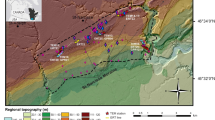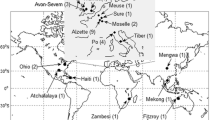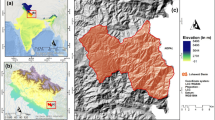Abstract
Remotely-sensed elevation data are potentially useful for constructing regional scale groundwater models, particularly in regions where ground-based data are poor or sparse. Surface-water elevations measured by the Shuttle Radar Topography Mission (SRTM) were used to develop a regional-groundwater flow model by assuming that frozen surface waters reflect local hydraulic head (or groundwater potential). Drainage lakes (fed primarily by surface water) are designated as boundary conditions and seepage lakes and isolated wetlands (fed primarily by groundwater) are used as observation points to calibrate a numerical flow model of the 900 km2 study area in the Northern Highland Lakes Region of Wisconsin, USA. Elevation data were utilized in a geographic information system (GIS) based groundwater-modeling package that employs the analytic element method (AEM). Calibration statistics indicate that lakes and wetlands had similar influence on the parameter estimation, suggesting that wetlands might be used as observations where open water elevations are unreliable or not available. Open water elevations are often difficult to resolve in radar interferometry because unfrozen water does not return off-nadir radar signals.
Résumé
Les données obtenues par télédétection peuvent être utiles pour l’élaboration de modèles hydrogéologiques à l’échelle régionale et particulièrement dans les régions où les données d’élévations du sol sont rares ou éparses. Les élévations des niveaux d’eaux de surface mesurées par la navette de la mission de topographie radar (SRTM) ont été utilisées pour élaborer un modèle hydrogéologique d’écoulement à l’échelle régionale, en faisant l’hypothèse que les eaux de surface gelées correspondent au niveau piézomètrique local (ou niveau des eaux souterraines). Les lacs de drainage (principalement alimentés par les eaux de surface) sont choisis comme conditions aux limites et les lacs d’infiltration et marais isolés (principalement alimentés par les eaux souterraines) sont utilisés comme zones d’observation pour calibrer un modèle numérique d’écoulement d’une zone d’étude de 900 km2, localisée dans la région des lacs du Northern Highland au Wisconsin, Etats-Unis. Les données d’élévations ont été utilisées avec une suite logicielle de modélisation hydrogéologique basée sur l’approche système d’information géographique (SIG) et utilisant la méthode des éléments analytiques (AEM en anglais). Les statistiques de la calibration montrent que les lacs et les marais présentaient une influence similaire sur l’estimation des paramètres, ce qui suggère que les marais pourraient être utilisés comme zones d’observation là où l’élévation des eaux de surface est non fiable ou non disponible. Les élévations des eaux de surface sont souvent difficiles à obtenir avec l’interférométrie radar car les eaux non gelées ne renvoient pas les signaux radar latéraux (off-nadir).
Resumen
Los datos de elevación provenientes de sensores remotos tienen un uso potencial para la construcción de modelos de agua subterránea de escala regional, particularmente en regiones donde los datos basados en el terreno son pobres o escasos. Se usaron elevaciones de la superficie del agua medidas por la Misión de Topografía Radar de Trayectos Cortos (SRTM) para desarrollar un modelo regional de flujo de agua subterránea mediante el supuesto de que las aguas superficiales congeladas reflejan la presión hidráulica local (o potencial de agua subterránea). Los lagos de drenaje (alimentados principalmente por agua superficial) se han designado como condiciones limitantes y los lagos de escurrimiento y humedales aislados (alimentados principalmente por agua subterránea) se han usado como puntos de observación para calibrar un modelo de flujo numérico de los 900 km2 del área de estudio en la Región de Tierras Altas al Norte de los Lagos de Wisconsin, Estados Unidos. Los datos de elevación se utilizaron en un Sistema de Información Geográfico (SIG) basado en un paquete de modelizado de aguas subterráneas que usa el método de elemento analítico (AEM). La calibración estadística indica que los lagos y humedales tuvieron influencia similar en la estimación de parámetros lo que sugiere que los humedales pueden usarse como observaciones donde las elevaciones de agua expuesta no son confiables o no están disponibles. Las elevaciones de agua expuesta son difíciles de resolver mediante interferometría de radar debido a que el agua no congelada no retorna las señales de radar nadir.





Similar content being viewed by others
References
Abdelfattah R, Nicolas JM (2002) Topographic SAR interferometry formulation for high-precision DEM generation. IEEE Trans Geosci Remote Sens 40(11):2415–2426
Attig JW (1985) Pleistocene geology of Vilas County, Wisconsin. Geological and Natural History Survey, Inform Circ Wisconsin 50:32
Bandilla K, Suribhatla R, Jankovic I (2005) SPLIT: Win32 computer program for analytic-based modeling of single-layer groundwater flow in heterogeneous aquifers with particle tracking, capture-zone delineation, and parameter estimation. University at Buffalo, Buffalo, NY
Becker MW (2006) Potential for satellite remote sensing of groundwater. Ground Water 44(2):306–318
Bourgeau-Chavez LL et al (2001) Analysis of space-borne SAR data for wetland mapping in Virginia riparian ecosystems. Int J Remote Sens 22(18):3665–3687
Chipman JW (2001) Topographic mapping of forested areas in the western Great Lakes region using spaceborne synthetic aperture radar interferometry. University of Wisconsin-Madison, Madison, WI, p 182
Dobson MC et al (1992) Dependence of radar backscatter on coniferous forest biomass. IEEE Trans Geosci Remote Sens 30(2):412–415
Dripps WR, Hunt RJ, Anderson MP (2006) Estimating recharge rates with analytic element models and parameter estimation. Ground Water 44(1):47–55
Durden SL, Vanzyl JJ, Zebker HA (1989) Modeling and observation of the radar polarization signature of forested areas. IEEE Trans Geosci Remote Sens 27(3):290–301
Elachi C (1980) Spaceborne imaging radar: geologic and oceanographic applications. Science 209(4461):1073–1082
Evans DL (1999) Applications of imaging radar data in earth science investigations. Electron Comm Eng J 11(5):227–234
ESRI (2001) ArcGIS. Environmental Systems Research Institute, Redlands, CA
Fredrick KC, Becker MW, Flewelling DM, Silavisesrith W, Hart ER (2004) Enhancement of aquifer vulnerability indexing using the analytic-element method. Environ Geol 45:1054–1061
Graczyk DJ, Hunt RJ, Greb SR, Buchwald CA, Krohelski JT (2003) Hydrology, nutrient concentrations, and nutrient yields in nearshore areas of four Lakes in Northern Wisconsin, 1999–2001. 03–4144, USGS, Reston, VA
Haitjema HM (1995) Analytic element modeling of groundwater flow. Academic Press, San Diego, CA, p 394
Haitjema HM, Mitchell-Bruker S (2005) Are water tables a subdued replica of the topography? Ground Water 43(6):781–786
Harrell PA, BourgeauChavez LL, Kasischke ES, French NHF, Christensen NL (1995) Sensitivity of ERS-1 and JERS-1 radar data to biomass and stand structure in Alaskan boreal forest. Remote Sens Environ 54(3):247–260
Hess LL, Melack JM, Simonett DS (1990) Radar detection of flooding beneath the forest canopy: a review. Int J Remote Sens 11(7):1313–1325
Hess LL, Melack JM, Filoso S, Wang Y (1995) Delineation of inundated area and vegetation along the Amazon Floodplain with the Sir-C synthetic-aperture radar. IEEE Trans Geosci Remote Sens 33(4):896–904
Hoffmann J (2005) The future of satellite remote sensing in hydrogeology. Hydrogeol J 13(1):247–250
Hunt RJ (2006) Ground water modeling applications using the analytic element method. Ground Water 44(1):5–15
Hunt RJ, Anderson MP, Kelson VA (1998) Improving a complex finite-difference ground water flow model through the use of an analytic element screening model. Ground Water 36(6):1011–1017
Jankovic I, Barnes R (1999) High-order line elements in modeling two-dimensional groundwater flow. J Hydrol 226:211–223
Jordan RL, Huneycutt BL, Werner M (1995) The SIR-C/X-SAR Synthetic Aperture Radar system. IEEE Trans Geosci Remote Sens 33(4):829–839
Kasischke ES, Melack JM, Dobson MC (1997) The use of imaging radars for ecological applications: a review. Remote Sens Environ 59(2):141–156
Krabbenhoft DP, Bowser CJ, Anderson MP, Valley JW (1990) Estimating groundwater exchange with lakes. 1. The stable isotope mass balance method. Water Resour Res 26(10):2445–2453
Kratz TK, Webster KE, Bowser CJ, Magnuson JJ, Benson BJ (1997) The influence of landscape position on lakes in northern Wisconsin. Freshw Biol 37(1):209–217
Levenberg K (1944) A method for the solution of certain non-linear problems in least squares. Q Appl Math 2:164–168
Lohmann D et al (2004) Streamflow and water balance intercomparisons of four land surface models in the North American land data assimilation system project. J Geophys Res Atmos 109(D7):22
Marquardt DW (1963) An algorithm for least-squares estimation of nonlinear parameters. J Soc Ind Appl Math 11:431–441
Matott LS (2005) OSTRICH: an optimization software tool: documentation and user’s guide. University at Buffalo, Buffalo, NY
McDonald KC, Dobson MC, Ulaby FT (1991) Modeling multifrequency diurnal backscatter from a walnut orchard. IEEE Trans Geosci Remote Sens 29(6):852–863
Michaels SS (1995) Regional analysis of lakes, groundwaters, and precipitation, northern Wisconsin: a stable isotope study. University of Wisconsin-Madison, Madison, WI, p 151
Moghaddam M, Durden S, Zebker H (1994) Radar measurement of forested areas during otter. Remote Sens Environ 47(2):154–166
NTL-LTER (2004) National Science Foundation, North Temperate Lakes Long Term Ecological Research. Center for Limnology, University of Wisconsin at Madison, Madison, WI
Patterson GL (1989) Water resources of Vilas County, Wisconsin, Miscellaneous Paper, Wisconsin Geological and Natural History Survey, Madison, WI, pp 46
Pint CD (2002) A groundwater flow model of the Trout Lake basin; calibration and lake capture zone analysis. University of Wisconsin-Madison, Madison, WI, p 123
Pint CD, Hunt RJ, Anderson MP (2003) Flowpath delineation and ground water age, Allequash Basin, Wisconsin. Ground Water 41(7):895–902
Poeter EP, Hill MC (1997) Inverse models: a necessary next step in ground-water modeling. Ground Water 35(2):250–269
Pope KO, Reybenayas JM, Paris JF (1994) Radar remote-sensing of forest and wetland ecosystems in the Central American tropics. Remote Sens Environ 48(2):205–219
Pope KO, Rejmankova E, Paris JF, Woodruff R (1997) Detecting seasonal flooding cycles in marshes of the Yucatan Peninsula with SIR-C polarimetric radar imagery. Remote Sens Environ 59(2):157–166
Rabideau AJ et al (2007) Analytic element modeling of supra-regional groundwater flow: concepts and tools for automated model configuration. J Hydrol Eng 12(1), (in press)
Rabus B, Eineder M, Roth A, Bamler R (2003) The shuttle radar topography mission: a new class of digital elevation models acquired by spaceborne radar. ISPRS J Photogramm Remote Sens 57(4):241–262
Rodriguez E et al (2004) An assessment of the SRTM topographic products: a final report to NIMA. Jet Propulsion Laboratory, California Institute of Technology, Pasadena, CA
Rusak JA (2005) Physical limnology of the North Temperate Lakes primary study lakes, North Temperate Lakes Long-term Ecological Research Program, Natural Science Foundation. Center for Limnology, University of Wisconsin-Madison, Madison, WI
Silavisesrith W, Matott LS (2005) ArcAEM: GIS-based application for analytic element groundwater modeling. Buffalo, NY
Smith LC (2002) Emerging applications of interferometric synthetic aperture radar (InSAR) in geomorphology and hydrology. Ann Assoc Am Geogr 92(3):385–398
Snedecor GW, Cochran WG (1980) Statistical methods. Iowa State University Press, Ames, IA, pp xvi and 507
Townsend PA (2002) Estimating forest structure in wetlands using multitemporal SAR. Remote Sens Environ 79(2–3):288–304
Ulaby FT, Sarabandi K, McDonald K, Whitt M, Dobson MC (1990) Michigan microwave canopy scattering model. Int J Remote Sens 11(7):1223–1253
Wang Y, Day JL, Davis FW (1998) Sensitivity of modeled C- and L-band radar backscatter to ground surface parameters in loblolly pine forest. Remote Sens Environ 66(3):331–342
Wuolo RW, Dahlstrom DJ, Fairbrother MD (1995) Wellhead protection area delineation using the analytic element method of groundwater modeling. Ground Water 33(1):71–83
Acknowledgements
This work was supported by the NASA New Investigator Program (NAG5-10608) as well as the NSF Information Technology Research Program (IIS-0426557). Development of software used for this research, Split, Ostrich, and ArcAEM, was funded by the US Environmental Protection Agency’s (EPA) Science to Achieve Results (STAR) program, under Grant No. R82-7961. Comments on the initial draft of the manuscript by Alan Rabideau are greatly appreciated. The author would like to thank Tom Farr of JPL for generously sharing remotely sensed data, as well as Jörn Hoffmann, Randall J. Hunt, and an anonymous reviewer for their thoughtful insight and critical review of this work.
Author information
Authors and Affiliations
Corresponding author
Rights and permissions
About this article
Cite this article
Fredrick, K.C., Becker, M.W., Matott, L.S. et al. Development of a numerical groundwater flow model using SRTM elevations. Hydrogeol J 15, 171–181 (2007). https://doi.org/10.1007/s10040-006-0115-3
Received:
Accepted:
Published:
Issue Date:
DOI: https://doi.org/10.1007/s10040-006-0115-3




